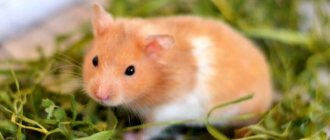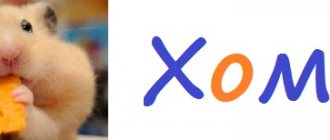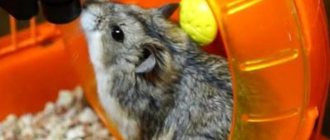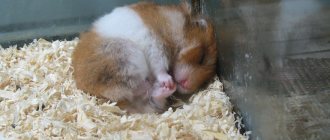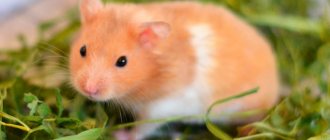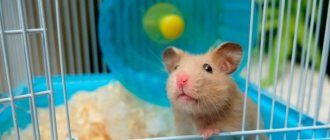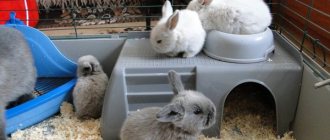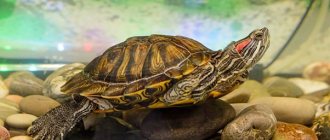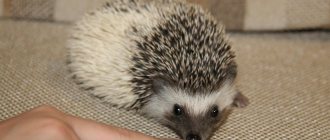- Cage interior
Dzungariki are small funny animals that can cheer up any person. If you decide to get a miniature rodent, then the Djungarian hamster is ideal for you. This animal gets along well with children, is not very picky in terms of food and does not require excessive attention. But in order for the animal to take root well in your home, you need to know how to properly care for a hamster.
Description of Djungarian hamsters
Djungarians are small rodents with an elongated body, a pointed muzzle and small five-fingered paws. They are distinguished from other breeds by their furry feet and short bushy tail.
Coat color and length
The hamster's fur is short and smooth. In nature, rodents are grayish-white in color with a dark stripe on the back.
Domesticated individuals differ from each other in different coat colors, including:
- standard - brownish-gray;
- sapphire - gray with a bluish tint;
- pearls - matte white with gray splashes;
- tangerine - reddish-cream.
Regardless of color, all jungarians have a light belly, the inside of the ears and paws.
Length and weight
Djungarians grow up to 10 cm in length. The size is the same for males and females. Animal weight - 25-75 g.
Character and lifestyle
Rodents live in steppes and semi-deserts. They are nocturnal: they hunt and gather food in the dark, and spend the day in labyrinthine burrows consisting of a sleeping nest and several chambers.
Animal shelters always have at least 2 exits so that they can escape in case of danger.
Both wild and domesticated hamsters are territorial and, when in close proximity to their own kind, experience stress, which causes fights. But with people, Djungarians are quite friendly and easy to tame.
Lifespan
Under natural conditions, the lifespan of the animal does not exceed 2.5 years. Pet rodents, if well cared for, can live up to 3 years.
Appearance
Dwarf hamsters are no more than 10 cm long and weigh 40-50 g. The animal is covered with thick short fur. The natural color is the most common: the back is gray-brown, with a pronounced black stripe along the spine. The belly is light, the inside of the paws is also white. The eyes are black, convex, shiny.
Colors of Djungarian hamsters
The natural color is most common, but in nurseries, by selecting spectacular mutations based on the coat, it was possible to obtain unusual colors. Tangerine follows the natural pattern, but the fur is not dark, but light brown, red. The color “sapphire” is gray-blue.
The rarest is the “pearl”, the white Djungarian hamster. Pearl color is characterized by the loss of a dark stripe along the ridge. The Djungarian hamster is not black or albino. This color variation indicates that this is a Campbell and not a Sungurik.
dzhungarik pearl color
A pet of an unusual color requires a responsible attitude: a “colored” rodent is less resistant to adverse conditions and stress. Thus, red hamsters are carriers of the lethal gene, so individuals of the same color should not interbreed.
spotted jungarik
In the wild, dark Djungarian hamsters are subject to seasonal molting. They lighten: they turn white or gray, although the dark stripe on the back remains. In an apartment, this phenomenon is rare, because the temperature does not drop below 16 C, and the daylight hours are constant.
jungarik sapphire color
Features of keeping a Djungarian hamster
Djungarians are easy animals to keep, but they also need to be looked after to maintain their health and activity.
To live a full life, your pet needs:
- ensure access to sufficient food and drink;
- provide an area for play and exercise;
- protect from stress;
- limit contact with other animals;
- maintain hygiene and cleanliness.
In addition to following the basic rules of care, it is necessary to carefully monitor the animal during games and walks so that it does not get lost or injured.
Habitat of jungariks
Many novice breeders, before getting a fluffy rodent, are interested in the life of Djungarian hamsters in the wild in order to provide them with conditions as close as possible to natural ones at home. Djungarian hamsters are representatives of a dwarf rodent species. In the wild, they live in the desert regions of Russia (in the Altai Territory and Western Siberia), Kazakhstan, China and Mongolia. “Fuzzies” got their name from the name of the province in the North-Western part of China - Dzungaria. Sometimes the Djungarian hamster is called the Sungur hamster, but this is the same species.
Dzungarians prefer a solitary life. The animals make their homes in small burrows up to one meter deep with 4-6 entrances and exits and several “rooms” (bedroom, pantry, latrine). During the day, the “fluffies” sleep, and at night they go in search of food. They happily eat grass, seeds of various plants, insects, and berries. In search of food, each hamster runs several kilometers during the night.
Choosing a home for a Djungarian hamster
Hamsters are small in size, so organizing a home is not a problem for them. You can use a purchased cage, an aquarium, or a homemade structure as a home.
Cell
A cage is a classic housing option for a hamster. Models with a fine metal grid are best suited for dzhungariks - this way the animal will not chew the bars or squeeze between them.
Options with a removable tray are convenient - they are easier to clean and change the bedding. It is recommended to choose plastic from the bottom material - it is easy to clean and does not absorb odors.
Cages with bars on the floor are not suitable for hamsters, as they must dig holes in the bedding. The recommended housing size is at least 30x50 cm for one animal.
Comfortable and spacious cage.
Aquarium
An aquarium for keeping a hamster is convenient because of its transparent walls, which make it easier to observe the animal, but it is more difficult to clean. As a home for rodents, you should choose only models with ventilation and a one-piece construction without gluing - otherwise the pet may be poisoned. Elongated rectangular aquariums are best suited for hamsters.
Terrariums and glass shelving
An aquarium alternative optimized for keeping animals rather than fish. It is compact and easy to monitor the animal, but is difficult to clean due to the lack of a removable bottom.
Dune
Dune is a spacious container with a transparent top and an entrance on the ceiling. It is distinguished by its convenience, ease of care, and cleanliness - the filler never spills out due to the solid construction of the house.
It is convenient to observe animals in such a home because of the transparent ceiling. Dunes with good ventilation are suitable for dwarfs - staying in a container without a special grill has a bad effect on the health of the animals.
Dune house for a hamster..
Houses made from scrap materials
To keep a hamster, you can use a spacious wooden box, a utility basin, a pulled out box and other similar containers. They must be made from environmentally friendly materials that are safe for animal health.
The walls of the makeshift home must be made high enough so that the pet cannot escape from the home. The recommended size corresponds to the standard cage dimensions.
Arrangement of the cage
After choosing a house, you need to place in it all the items and accessories necessary for the rodent’s life. The hamster needs a shelter for sleeping, resting and storing food supplies, a feeder and water bowl, and at least 1 toy for running and exercise.
Additionally, various functional decorative objects are placed in the cage, making watching the pet more interesting and helping to diversify the animal’s leisure time.
Drinker and food bowls
It is advisable for the hamster to have 2 food bowls - for dry grain food and fresh vegetables and fruits.
Feeders should be shallow so that it is convenient for the hamster to get food out of them.
For water, special drinking bowls with a dispenser are used, because when using a bowl of water, the animal wets its paws and spreads dirt throughout the cage. The water is changed daily.
Pet drinking bowl.
Sports area
A good addition to the cage would be an area for play and exercise. Specially equipped labyrinths and playgrounds are well suited for this purpose, but you can organize a sports area yourself by installing various toys.
Filler
The bottom of the cage must be covered with filler. The minimum layer thickness is 2 cm. Sawdust or special granular fillers are best suited for dzungaria.
They should not be too small so as not to get into the animal’s respiratory tract. Fibrous materials such as cotton wool, lint and cloth are not suitable for rodents as they can become entangled or ingested by hamsters, leading to intestinal obstructions and other health problems.
In addition to the filler, the dwarf needs to be provided with soft nesting material for its sleeping place.
Soft napkins or scraps of paper are best suited for this. They should not contain fragrances or topographic paint. Paper with cutting edges, such as office paper, is also not suitable.
Hamster cage filler.
running wheel
A running wheel is necessary to ensure that the animal can maintain its level of physical activity. If this is not possible, your pet will develop health problems such as obesity.
A hamster wheel should be without spokes, with a ribbed coating. Products with a lattice bottom are not suitable for dungeons, as their small paws will fall through. The stand or wheel mount must be located at least 1 cm from the surface of the machine.
Wheel for fun.
Additional accessories
In addition to the main items, additional toys and accessories can be placed in the cage.
These include:
- crossbars;
- stairs;
- hammocks;
- tunnels;
- toys with treats inside.
All accessories should be made from environmentally friendly, healthy materials, since hamsters have a habit of chewing everything that is nearby.
Communication
Djungarians have an independent character and are not too eager to communicate. To wean the animal from biting and fearlessly picking it up, it will have to be patiently tamed day after day. It will not be possible to raise a hamster once and for the rest of its life: if you do not have contact with it for 1-2 weeks, the pet will run wild again, and hand training begins all over again.
Keeping an animal with a nocturnal lifestyle means not disturbing it during daytime sleep, being content with communicating and observing it in the evening hours. You will have to endure noise at night: the hamster will run in a wheel, chew the bars of the cage and toys, dig for litter, rustle with paper in the house.
How to tame a Djungarian hamster
Young dwarfs are best suited for taming. It is worth starting it 2-3 days after purchasing the animal, so that it has time to get used to its new home.
Taming stages:
- Get to know the animal. Without making direct contact, the owner needs to be near the cage more often so that the animal gets used to the voice and smell of a person.
- Offer a treat. When the rodent gets used to the presence of a person, you can stick your hand into the cage with a treat on it. Most likely the hamster will not go to pick up the treat in the first 2-3 days, but over time he will climb onto your hand. During this period, you should not immediately try to lift it - the pet should get used to it and begin to feel safe.
- Get used to your hands. When the animal begins to climb into your palm without fear, you can try to lift it, covering it with your other hand. The procedure must be repeated daily until the animal is completely accustomed to its owner.
When taming a hamster, it is necessary to carefully monitor the animal's mental state. If it shows signs of aggression or stress, you should return your pet to the cage and continue training the next day.
What you need to know before purchasing
It is advisable to learn everything about Djungarian hamsters before purchasing. The life expectancy and health of your pet will depend on your care. How you treat him is how he will treat you.
- Immediately upon being brought home, the hamster must be placed in ready-made housing. When moving, the animal is guaranteed to be stressed, since everything it knew has disappeared. Once in a new place, for some time you will be afraid to even stick your nose out. The only thing that saves him is a house where he can hide and get away from the stress. At this time, he should not be disturbed; let him get used to the new environment. Only when the pet comes out on its own and explores its new place of residence, can you try to make contact with it.
- It is advisable to accustom hamsters to handling while they are small. This will become more and more difficult to do with age. Once the rodent has recovered from the stress, you can slowly make contact. How to train a hamster to be handled, read here: taming a hamster. You can play with him every day so that he gets used to human hands.
- There should only be one hamster in one cage. Dzungarians are loners and will not tolerate strangers on their territory. For those who want to have several rodents and place them in one cage, the Roborovsky hamster is more suitable.
Nutrition of the Djungarian hamster
The basis of a hamster's health is proper nutrition. The diet should be healthy, rich in nutrients and close to the animal’s menu in natural conditions.
Mode
Hamsters are nocturnal animals, so it is best to feed them close to dark. A two-time diet is optimal: the animal receives 70% of its food in the evening, and the remaining 30% early in the morning.
Diet
It is best to give hamsters special ready-made food in combination with bait from fresh vegetables and protein foods.
List of products allowed for dzungaria:
- cereals - oats, wheat, barley, rye, corn;
- sesame and flax seeds, in small quantities - sunflower and pumpkin;
- nuts, except Brazil, almond and pine;
- low-starch vegetables, greens;
- sour and moderately sweet fruits and berries;
- protein component (1-2 times a week) - boiled egg white, lean chicken or fish.
In addition to food, animals need round-the-clock access to drinking water. It is changed daily.
Hamster breakfast.
Toys for grinding teeth
A hamster's teeth grow quickly, so the animal needs to chew on hard objects to wear down. To prevent it from using rods or a house for this purpose, you need to buy it several special toys.
They are made from dried grains and hay, so they are safe for health. In addition to toys, branches of fruit trees and mineral stones are well suited for grinding - they not only maintain your pet’s oral hygiene, but also supply the body with minerals and nutrients.
Natural stone for grinding teeth.
Care and maintenance at home
The natural habitat of Djungarian hamsters extends to semi-fixed sands, as well as gravelly-cinquefoil, wormwood, grass-desert and xerophytic zones of the steppes of North-Eastern Kazakhstan and Central Asia, including the territory of the central regions of Asia, as well as the Western Siberian District.
Therefore, the conditions for keeping this animal in captivity should be as close as possible to natural ones. Maintenance experience shows that Djungarian hamsters, despite the ease of maintenance, still require competent and constant care.
How many jungarians to have?
According to experts, it is permissible to keep only one animal in one cage, regardless of gender. This is due to the fact that these animals are quite territorial and in limited space, capable of showing aggression towards each other.
As a result of keeping several animals in one area, they develop a feeling of permanent stress. In this state, they are capable of inflicting injuries on each other, sometimes incompatible with life. Therefore, each animal purchased for the purpose of further maintenance must be housed in a separate cage.
Selecting a cage and filling it
Keeping Djungarian hamsters at home does not involve any special problems; it is enough to choose the right cage and fill it correctly. The most suitable cage for this small animal may have dimensions of 300x500 mm. A special cage made of transparent plexiglass is also suitable. The pet's cage must contain:
- Bedding in the form of finely sifted sand or medium-sized compressed sawdust. These materials are quite cheap, but at the same time they perfectly absorb moisture and also absorb unpleasant odors. It is not recommended to use cotton wool, paper napkins, newspapers, rags, etc. as bedding.
- Special toilet for keeping small domestic rodents. Special absorbent components are poured into such trays. Typically these are called fillers.
- Holes that can represent various roots, plant branches and tubes.
- Holiday house. This can be the most primitive structure made of wood or other environmentally friendly material.
- A wheel with transverse protrusions and without a grid in the bottom.
A wide range of similar and other accessories are sold in pet stores. The main thing is that there are enough of them, but not too many. A convenient drinking bowl and feeder must be present in the animal’s cage; a drinking bowl with a volume of about 50 ml is sufficient. It is necessary to ensure that the water in the drinking bowl is changed daily. The feeder should have standard sizes, depending on the size of the animal.
It is important to know! It is not recommended to keep these animals in aquariums with high walls, since the space inside them is poorly ventilated. Therefore, the internal surfaces often fog up, which negatively affects the health of jungarians.
When filling an animal's cage with various accessories, one should not forget about a special stick or mineral stone. They are necessary so that the animal can grind down its teeth. A twig of any fruit tree, with the exception of apricot and cherry, is suitable as a stick.
Care and hygiene
The main feature of caring for a hamster is proper and timely cleaning, which will help prevent the appearance of a persistent and rather unpleasant odor in the home. Cleaning the animal's toilet, including replacing the litter, is carried out at least 1 or 2 times a week. To clean the cage properly, the animal is temporarily transferred to a special container or box.
The most important thing is that the filler should not be removed completely, since a small part of the old filler will help the animal quickly adapt to the conditions after cleaning. This way he will immediately find his toilet, which is very important. Once a month, you should do a thorough cleaning of your pet rodent's cage. In this case, you should not touch the hamster's nest. To wash the bottom of the cage, it is better to use regular laundry soap.
Important to remember! Djungarian hamsters do not need water procedures, since they know how to clean their fur; to do this, they will have to place a special bathing suit with clean, sifted sand in the cage.
It is very important to find the right place for your pet, since animals do not like to be in direct sunlight. They are also negatively affected by drafts and stagnant air. Therefore, the cage should not be located near the TV, refrigerator or computer, and especially not near heating appliances.
What to feed
The most suitable option in this case is to use ready-made commercial food for hamsters. The basis of the diet should be granules and grain mixtures consisting of seeds, grains and pieces of chopped corn. The protein content should be at the level of 15-20 percent. Such granules and mixtures play an important role in the dental hygiene of hamsters. They are also highly concentrated in nutrients. Despite this, they do not represent the only type of food for Djungarian hamsters.
The diet of a domestic rodent, depending on the season, can be expanded to include fruits, vegetables, and herbs. In this case, the expansion of the diet should be carried out gradually, with observation of the animal’s reaction. If diarrhea occurs, which indicates an allergy, it is better to exclude such products from the diet.
Important point! Hamsters should not be allowed to eat raw potatoes, onions, garlic, tomato tops, as well as citrus fruits, watermelons, melons, almonds and chocolate.
Djungarian hamster - care and maintenance | DETAILED INSTRUCTIONS
Health, disease and prevention
The owners of these animals note that many of their illnesses are directly related to the severe stress they have experienced.
Stress can result from:
- Changing the location of the cell.
- Disturbances in sleep and rest patterns.
- Long trip.
- The appearance of another individual in the cage.
If the animal begins to show unmotivated aggression or has heavy breathing or noticeable ulcers on the body, as well as frequent and loose stools, then its further maintenance requires medical attention or consultation with a veterinarian. The fact that an animal is sick can be judged by the manifestation of apathy, a convulsive state, a complete loss of appetite, as well as severe loss of fur.
Reproduction and offspring
In captivity, Djungarian hamsters demonstrate enviable fertility. Females 4 months of age and males who have reached 3 months of age or older take part in the breeding process. After mating, the female carries her offspring for 3 weeks. To feed pregnant females, not only ready-made commercial feeds are used, but also protein foods in the form of boiled chicken breast, egg (boiled) yolk and low-fat cottage cheese.
Before the birth of hamster offspring, it is necessary to carry out complete disinfection of both the cage and all accessories. After birth, the cubs are fed exclusively on mother's milk for the first 3 weeks. During this period, under no circumstances should you pick up small animals, since after this the female is able to eat her offspring.
Hairy-footed Djungarian hamsters are capable of reproducing healthy offspring when crossed with Campbell's hamsters. Experts point out that the offspring obtained in this way have an average life expectancy, which is at the level of one and a half years. Hybrid individuals have a slightly different coat color, characterized by a reddish tint. At the same time, they have a characteristic body structure.
Interesting to know! If you provide the female with high-quality housing conditions, you can get fairly healthy offspring.
Already on the fourth or fifth day, the small animals stop constantly squeaking and begin to behave more calmly. After a week, their body begins to be covered with real wool. After a week and a half, the offspring begins to move independently around the cage. Somewhere around this time, they already begin to try soft food. After a couple of weeks, the offspring can already see and hear. After about a month, the babies can be separated from the female.
Rules for caring for a Djungarian hamster
Djungarians do not require special care. They maintain their hygiene on their own, grinding down their claws and teeth. Owner intervention is necessary only in case of obvious discomfort of the animal.
Walks and games
The hamster can be let out to walk around the room. Before this, you need to remove all potentially dangerous objects from the room, block the gaps between the furniture, and drive out other pets.
It is categorically not recommended to release the dwarf on the street - there it is almost impossible to protect the animal and keep it from escaping.
Water treatments
It is not recommended to bathe dwarfs. These clean animals take care of their fur themselves, washing and cleaning it. In case of heavy contamination (from food, detergents, etc.), the hamster’s fur is wiped with a cloth soaked in warm water, and then wiped dry.
Nail trimming
Regular nail trimming is not required for jungarians, since the animals themselves bite off the overgrown stratum corneum. The procedure is carried out if the nail extends beyond the finger and causes discomfort to the animal.
Haircut instructions:
- Place the animal on your palm with its belly down and squeeze its paw between your middle and index fingers. The animal must not move.
- Bring the scissors from below and cut off each claw one by one.
- Repeat the procedure with the remaining paws.
For cutting, it is best to use nail scissors with rounded edges. Before starting work, they are lubricated with an antiseptic.
Be extremely careful when trimming nails.
Reproduction of Djungarian hamsters
Rodents reach sexual maturity at 1-1.5 months, but for breeding it is better to take individuals no younger than 5, since early pregnancy leads to health problems.
The meeting of a girl and a boy is carried out on neutral territory or in the male’s cage during the period of estrus. Immediately after mating, the couple is seated. Pregnancy lasts from 21 to 26 days.
A week before giving birth, cage care and any contact with the female should be stopped, with the exception of changing water and food and in feeders. It can be resumed only after 2-3 weeks, when the cubs have grown up - otherwise the mother may abandon them.
In the hamster's diet during the period of bearing and caring for the offspring, it is necessary to increase the proportion of protein by giving bait daily.
The cubs begin to be separated from their mother a month after birth. It is permissible to give hamsters to new owners from the age of 45 days.
Little hamsters.
Choosing a dwarf hamster
You decided to buy a hamster, you went to the pet store, and there were dozens of them. The choice is very difficult to make. What should you pay attention to when choosing an animal? Here are some useful tips:
- age. Remember that small djungarian hamsters are much faster to tame and are more amenable to training;
- floor. It is difficult to determine the gender of very tiny babies, but in animals older than 1 month, sexual characteristics are already visible. The animal must be turned over on its back and the underbelly examined. By the way, males are more friendly, but females sometimes show aggression. If you want a married couple for breeding, take both a boy and a girl;
- behavior. If some Khoma asks to come into your hands, pay attention to him. Perhaps the animal has already been domesticated, then the process of adaptation in your home will be easier;
- health status. This is the most important point when choosing. Carefully inspect the animal for parasites, bald spots in the fur, discharge in the eyes and nose - there should be none! If these signs are present, the homa is clearly sick, and it will be very difficult to treat the animal.
And one more thing: if you want an animal of a certain color, it is better to buy it in the summer. So, a white dwarf bought in winter may turn brown by summer.
Prevention and treatment of diseases
The most common diseases of dzhungariks:
- obesity;
- diseases of the cardiovascular system;
- problems with the gastrointestinal tract;
- eye pathologies;
- dermatitis.
To prevent diseases, you need to monitor the animal’s nutrition and hygiene, provide conditions for physical activity, protect the hamster from hypothermia and stress, and ensure that it does not get injured during walks and games.
It is not recommended to treat jungaric diseases on your own. It is difficult to carry out home diagnostics, and improper care can worsen the pet’s condition. Djungarian hamster
Therefore, if symptoms of the disease appear, the animal should be taken to a veterinarian or a more specialized rodent specialist - a ratologist.
Additional recommendations
Hamsters begin to age at 15 months of age. This is reflected in the deterioration of the health of their heart, respiratory and digestive systems, and teeth. To avoid a decline in quality of life, from this age more vitamins and mineral baits need to be introduced into the hamster’s diet.
Hamsters are nocturnal animals, so it is advisable to communicate with them closer to the dark - in the morning or evening. It is undesirable to disturb an animal during the day or disrupt its sleep pattern - this leads to aggression and health problems.
Health
A common disease in Djungarian hamsters is diabetes mellitus. To avoid health problems, your diet should not contain many monosaccharides, which are found in many fruits.
In addition, there are injuries, colds, dermatitis, and infection with external parasites. Any altered condition of the animal requires immediate attention to a veterinary hospital.
The Djungarian hamster is a funny animal, reviews of which are entirely positive. Pets are good for observation, but not particularly good for communication. With proper care, they live their short lives happily and serenely to the delight of their owners.
Important Warnings
It is important to protect hamsters from stress. Animals are quite shy, so it is advisable to minimize their contact with any irritants: sharp sounds, smells, strangers and other pets.
Djungarians take care of their fur on their own, so dirty, crumpled or damp fur indicates health problems. Diseases are also indicated by any discharge in the eye or nose area. When they appear, you need to show the animal to a veterinarian.
Hamsters live on plains, so they often fall from horizontal surfaces. Because of this feature, it is not recommended to leave the animal on a table, chair or bed - a fall can lead to injury to the animal.
